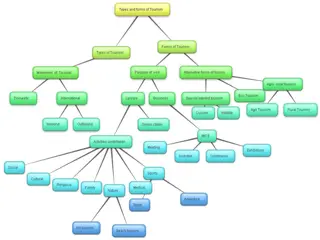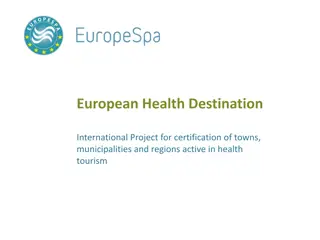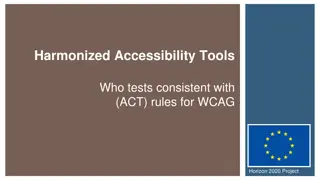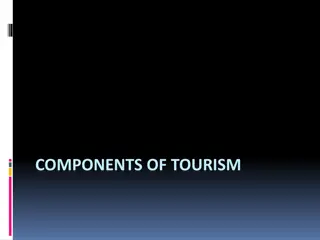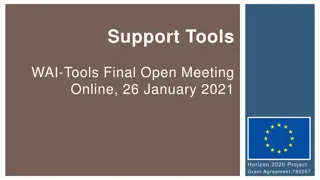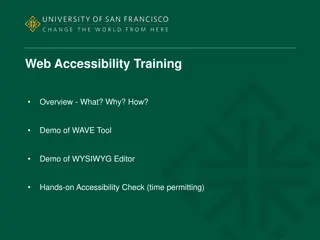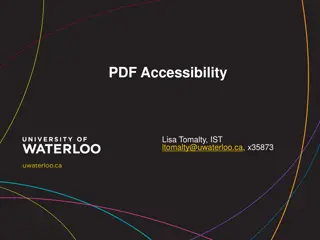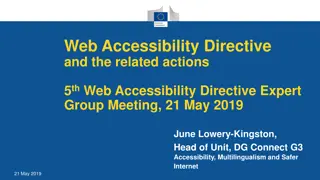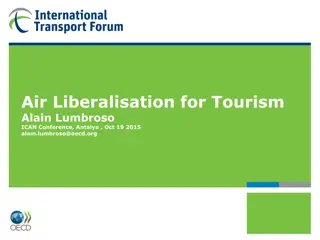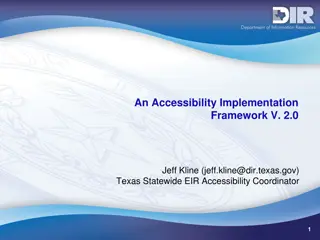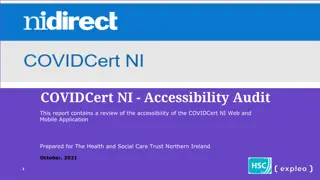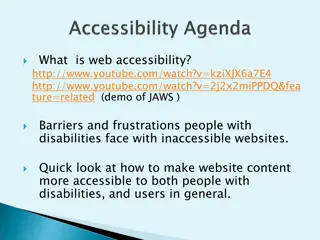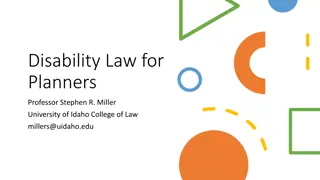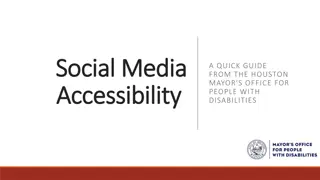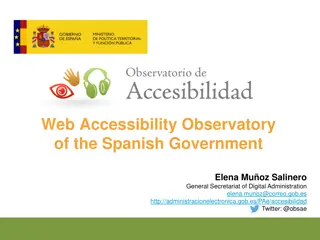Understanding the European Accessibility Act for Enhanced Accessible Tourism
The European Accessibility Act aims to establish minimum accessibility requirements across various products and services, including tourism, to empower individuals with disabilities. This act builds upon the UN CRPD Article 9, emphasizing equal access and participation. The directive, adopted in 2019, tasks EU Member States with transposing it into national laws by June 2025, facilitating accessible goods and services in the EU internal market.
Download Presentation

Please find below an Image/Link to download the presentation.
The content on the website is provided AS IS for your information and personal use only. It may not be sold, licensed, or shared on other websites without obtaining consent from the author. Download presentation by click this link. If you encounter any issues during the download, it is possible that the publisher has removed the file from their server.
E N D
Presentation Transcript
European Accessibility Act and what it means for accessible tourism Dr. Marion Steff, International Cooperation Manager European Disability Forum Presentation CE-Spaces4All meeting Znojmo | 21 May 2024
European Disability Forum (EDF) Who we are 100 million persons with disabilities in the EU Brussels-based umbrella organisation Advocating for the rights of persons with disabilities Implementation of the UN CRPD in the EU and member countries Nothing about us without us!
Legal Framework for Accessibility UN CRPD Article 9 Accessibility: To enable persons with disabilities to live independently and participate fully in all aspects of life, States Parties shall take appropriate measures to ensure to persons with disabilities access, on an equal basis with others ( ) To develop, promulgate and monitor the implementation of minimum standards and guidelines for the accessibility of facilities and services open or provided to the public . The Accessibility Act does not create new requirements the Member States are already obliged to implement the UNCRPD which goes much further.
Introduction to the European Accessibility Act (EAA) EU law that will set EU-wide minimum accessibility requirements for a range of mainstream products and services, including related to tourism Aims to strengthen the right of persons with disabilities to access goods and services available in the EU internal market and contributes to accessible tourism Directive - sets binding accessibility goals but leaves it up to the EU Member States to decide how they want to reach them Adopted in 2019, and Member States need to transpose to national law by June 2025 (this means introduce new and/or update existing national legislation to comply with the Act)
What goods and services are covered by EAA? Computers and operating systems ATMs, ticketing and check-in machines for the provision of the services All payment terminals Telephone services and smartphones Emergency calls to 112 TVs and access to the audiovisual media services Consumer Banking services e-books and e-readers e-commerce Certain elements of transport services
Exemptions Exemption of microenterprises providing services Self-service terminals installed inside transport vehicles, aircrafts, ships or rolling stock do not have to be accessible Websites, mobile apps, electronic tickets and electronic ticketing services, and delivery of transport service information, including real time travel information of urban, suburban and regional transport services do not have to be accessible. Making the built environment accessible is optional for Member States.
Enforcement Enforcement mechanisms by market surveillance authorities use of CE marking Organisations can take action before the European Court of Justice Penalties & possibility to withdraw products from the EU internal market
Examples Accessibility Requirements General requirements for services: providing information about the functioning of the service, and where products are used in the provision of the service, its link to these products as well as information about their accessibility characteristics and interoperability with assistive devices and facilities making websites, including the related online applications, and mobile device-based services, including mobile applications, accessible in a consistent and adequate way by making them perceivable, operable, understandable and robust
Examples Accessibility Requirements Specific services: E-commerce services: a) providing the information concerning accessibility of the products and services being sold when this information is provided by the responsible economic operator b) ensuring the accessibility of the functionality for identification, security and payment when delivered as part of a service instead of a product by making it perceivable, operable, understandable and robust c) providing identification methods, electronic signatures, and payment services which are perceivable, operable, understandable and robust
Useful links: EDF Resources EDF Toolkit for transposition: European Accessibility Act EDF webinar on the EAA toolkit EDF introductory webinar on European Accessibility Act - June 2019 EDF resources and fist analysis of EAA after publication EDF members: National disability councils
European Disability Forum 7-9 Avenu des Arts 1210 Brussels, Belgium www.edf-feph.org Marion.Steff@edf-feph.org; Ansofie.Leenknecht@edf-feph.org Facebook.com/CESpaces4All Linkedin.com/company/ce-spaces4all/ Youtube.com/@CE-Spaces4All Instagram.com/ce_spaces4all/



